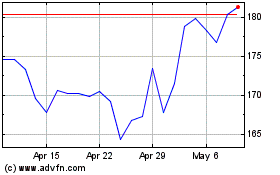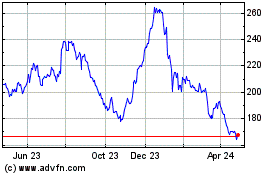By Jon Ostrower
Boeing Co. is on pace to achieve a rare feat in its industry:
delivering a new jetliner ahead of schedule.
The 737 Max, an updated version of its best-selling single-aisle
jet, completed its first flight Friday, a key step toward Boeing's
goal of delivering the first plane to Southwest Airlines Co. in the
third quarter of 2017.
Behind the scenes, industry officials say, Boeing is telling
customers it might deliver the jet as much as six months early.
Just being on time would be remarkable. Aerospace companies in
recent years have struggled with on-time deliveries of products,
including commercial jetliners, business jets, military transports
and fighter aircraft, because of technical and production
problems.
Boeing hasn't been immune. Its flagship 787 Dreamliner and the
updated 747-8 version of its iconic jumbo jet were years behind
schedule and suffered billions of dollars in cost overruns.
The 737 Max is the fourth big change in the 50-year history of
the 737, the best-selling jetliner of all time. Boeing received its
first orders for the model in late 2011 at a time of high fuel
prices. The plane boasts new engines and improved aerodynamics that
the company said could cut fuel consumption by at least 14%
compared with prior models.
Boeing needs a smooth transition to the Max from the existing
plane to ensure its cash-cow status continues uninterrupted.
Analysts estimate the 737 accounts for between 40% and 45% of the
operating profit of the company's commercial-airplane business.
"The 737 has been the meat and potatoes for the company," said
Herb Kelleher, a founder and former chief executive of Southwest.
"I think it has been a sustaining element for Boeing for a
considerable period of time, something they could always count upon
in bad times as well as good."
Southwest only flies 737s and has ordered 974 of them, including
200 Max versions.
Rival Airbus Group SE has eroded Boeing's traditional dominance
of the single-aisle market, and it had a jump on upgrading its own
offering. Airbus began signing up customers for a new version of
its competing A320 with more fuel-efficient engines a year before
Boeing started selling the 737 Max.
Airbus on Jan. 20 delivered to Deutsche Lufthansa AG the first
of those A320neo jets, which through 2015 had garnered 4,471
orders, compared with 3,072 for the new Boeing jet.
Progress on the 737 Max could still hit obstacles. Flight
testing, for example, could reveal unexpected problems. Still, the
737 Max is an update, rather than an all-new model like the 787,
requiring fewer tests. Boeing also is planning conservatively,
allowing six years from program launch to delivery, compared with
just four years it originally allotted for the 787--which ended up
being nearly eight years after delays. Boeing's test pilots said
they plan nine months of aerial tests for the Max, but have given
themselves 20 months--the same as the 787, despite that plane's
bigger technological leap.
"I don't want to cut [the allotted testing time] to the bone and
have to add days on to the end, and unfortunately we have done that
in the past, " said Keith Leverkuhn, Boeing's program manager for
the 737 Max.
While big upgrades like the Max are tied to advances in engine
technology, Boeing has incrementally improved the 737's design over
many years. The result is a deep pool of Boeing engineers who know
the plane well, making more-extensive upgrades easier, say current
and former Boeing executives.
The 737 Max adopts some of the Dreamliner's advances, such as
consolidating traditionally analog cockpit indicators onto
laptop-sized widescreen displays. But it retains some of the 737's
1960s attributes, such as its switch-laden overhead panel and
analog indicators, which helps airlines keep their pilots trained
and certified for the new jet--critical for their cost
calculations.
While the list price of a 737 has steadily increased--currently
$110 million for the most popular model of the Max, the cost to
airlines after discounts has come down. A new 737 Max sells for
about $51 million, including average discounts, compared with an
inflation-adjusted $58 million for a new 737-400 in 1990, estimates
Avitas, an aircraft valuation and consulting firm. The same has
been true for Airbus jets.
The downward pressure on prices is reflected in airplane
factories that have been transformed over the past two decades.
Boeing's Renton, Wash., plant builds 42 737s a month, twice the
rate of 10 years ago and all under the same roof. By 2019, the
number is expected to be 57.
Boeing hopes to build the 737 Max for at least 15 years, and
Chief Executive Dennis Muilenburg last week said Boeing remains
confident in its strategy of updating its best seller rather than
pushing an all-new plane. But customers and company staff say
Boeing officials privately have expressed concern and are devising
ways to more quickly recoup market-share losses, particularly for
the biggest single-aisle aircraft. Airbus currently has nearly four
times as many orders as Boeing in that market segment.
Customers are pushing for an all-new jet, bigger than the Max
but smaller than the Dreamliner. Boeing also is studying a
less-expensive option that would be ready sooner. The design
features new wings and stretches the 737's body to seat up to 245
passengers and adds taller landing gear to make room for larger
engines, said people familiar with the studies.
Mr. Leverkuhn defended the largest 737 Max, which Boeing aims to
deliver in 2018, and said the cost to fly a trip in the biggest 737
is lower than its Airbus counterpart and its design is exceeding
its original performance. "We're comfortable with where the
airplane is landing," he said.
Write to Jon Ostrower at jon.ostrower@wsj.com
(END) Dow Jones Newswires
February 02, 2016 05:44 ET (10:44 GMT)
Copyright (c) 2016 Dow Jones & Company, Inc.
Boeing (NYSE:BA)
Historical Stock Chart
From Mar 2024 to Apr 2024

Boeing (NYSE:BA)
Historical Stock Chart
From Apr 2023 to Apr 2024
